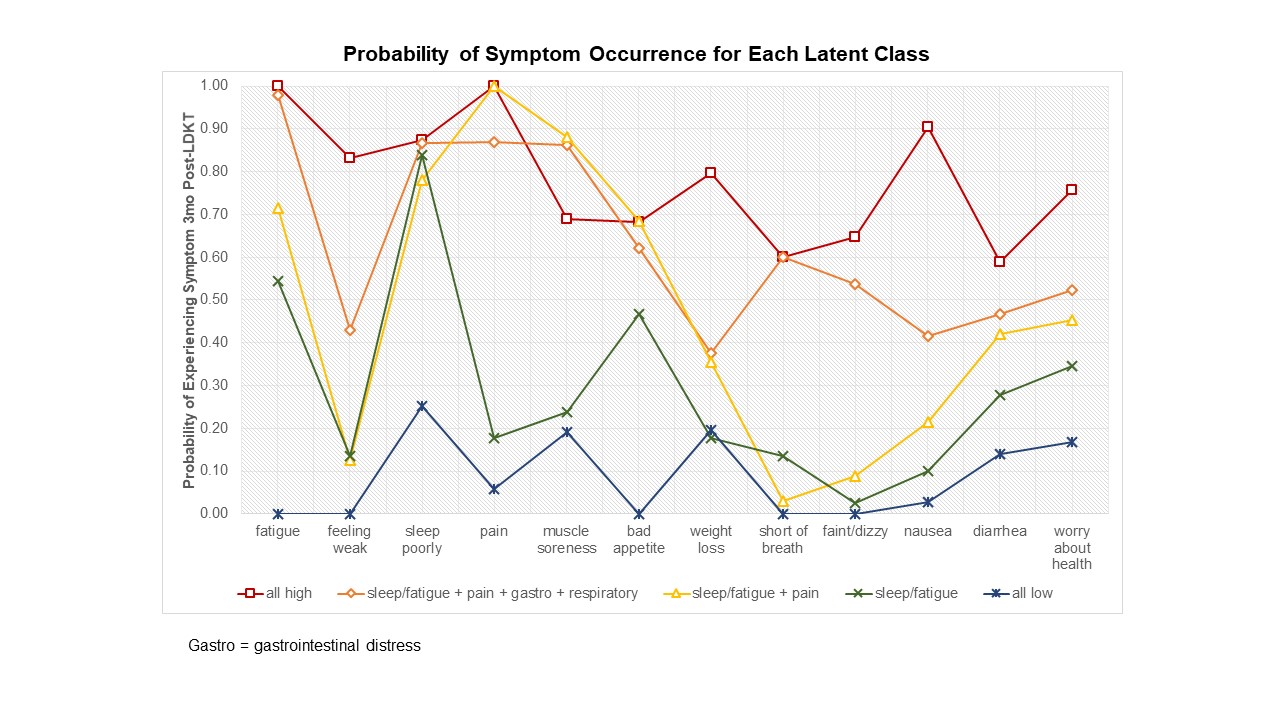Use of Latent Class Analysis to Identify Patient Symptom Burden Subgroups after Living Donor Kidney Transplant
J. Peipert, J. Caicedo-Ramirez, K. Ensor, J. Friedewald, M. Abecassis, D. Cella, D. Ladner, Z. Butt
Northwestern University, Chicago, IL
Meeting: 2019 American Transplant Congress
Abstract number: 182
Keywords: Quality of life
Session Information
Session Name: Concurrent Session: Psychosocial and Treatment Adherence
Session Type: Concurrent Session
Date: Sunday, June 2, 2019
Session Time: 4:30pm-6:00pm
 Presentation Time: 4:54pm-5:06pm
Presentation Time: 4:54pm-5:06pm
Location: Room 208
*Purpose: Identifying groups of patients based on clusters of symptoms they experience may help advance our understanding of living donor kidney transplant (LDKT) recipients’ post-operative well-being.
*Methods: At 3 months post-LDKT, we assessed 18 symptoms drawn from two kidney-targeted symptom scales among 404 LDKT recipients transplanted between 11/2007 and 08/2016: the Kidney Disease Quality of Life – Symptoms and Problems of Kidney Disease and the Functional Assessment of Cancer Therapy – Kidney Symptom Index. Each symptom was coded as present vs. absent. We then used latent class analysis (LCA) to identify subgroups of patients experiencing distinct latent classes of symptoms and to determine if patient characteristics were associated with latent symptom classes.
*Results: Five classes of symptom experience were identified: “all symptoms low” (11% of patients), “sleep problems/fatigue” (31%), “sleep problems/fatigue + pain” (20%), “sleep problems/fatigue + pain + gastrointestinal distress + respiratory distress” (33%), and “all symptoms high” (5%). The figure shows the probability of experiencing select symptoms for each latent symptom experience class. Patients in the “all symptoms high” class had a high probability of experiencing each symptom, and patients in the “all symptoms low” class had a low probability of experiencing each symptom. In between, we identified groups of patients (“sleep problems/fatigue,” “sleep problems/fatigue + pain”) with high probability of some symptoms but low probability others (e.g., gastrointestinal distress), as well as a group of patients with high probability of all symptoms from the “sleep problems/fatigue + pain” class, but adding higher probabilities of gastrointestinal and respiratory distress. Male patients were significantly more likely to be in the “sleep problems/fatigue” (b=0.97, p=0.04) and “all symptoms low” (b=2.42, p=0.002) classes, while age was significantly associated with membership in the “sleep problems/fatigue + pain + gastrointestinal distress + respiratory distress” class (b=0.03, p=0.05).
*Conclusions: This study improves upon previous research by identifying not only common symptoms, but also “phenotypes” of patients more and less likely to experience distinct groups of symptoms, painting a more comprehensive picture of post-LDKT health. In doing so, we found significant variation in symptom experience after LDKT, with older and female patients experiencing multiple bothersome symptoms. The results of this study can be used to target patients for symptom management interventions.
To cite this abstract in AMA style:
Peipert J, Caicedo-Ramirez J, Ensor K, Friedewald J, Abecassis M, Cella D, Ladner D, Butt Z. Use of Latent Class Analysis to Identify Patient Symptom Burden Subgroups after Living Donor Kidney Transplant [abstract]. Am J Transplant. 2019; 19 (suppl 3). https://atcmeetingabstracts.com/abstract/use-of-latent-class-analysis-to-identify-patient-symptom-burden-subgroups-after-living-donor-kidney-transplant/. Accessed December 18, 2025.« Back to 2019 American Transplant Congress

